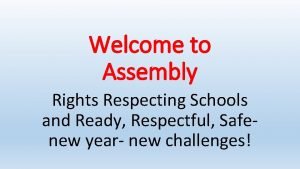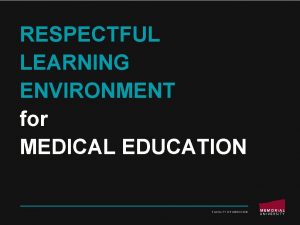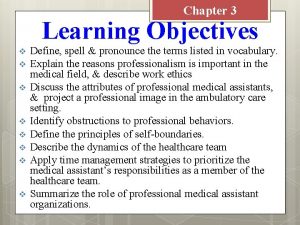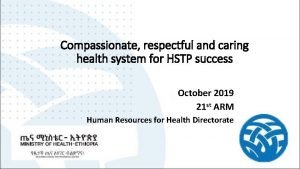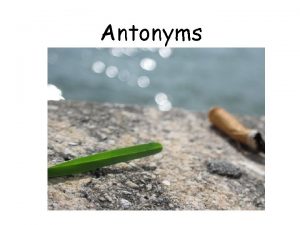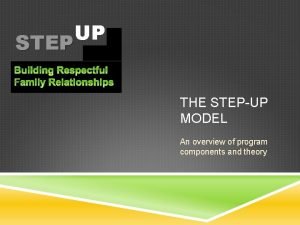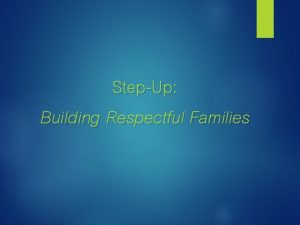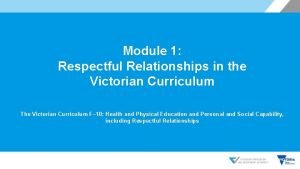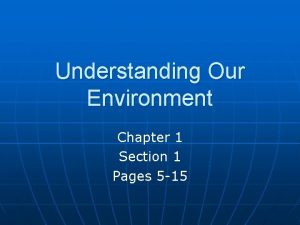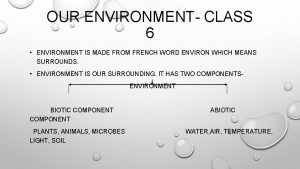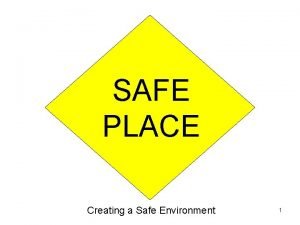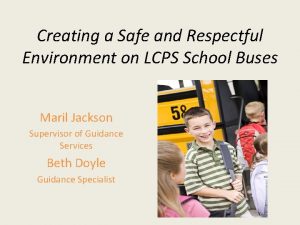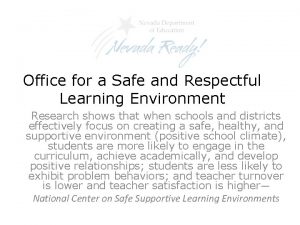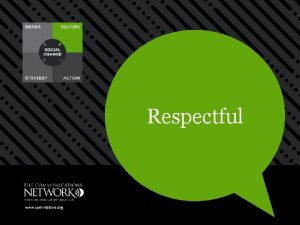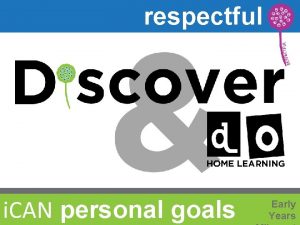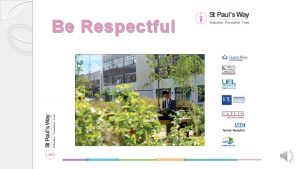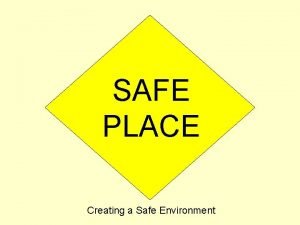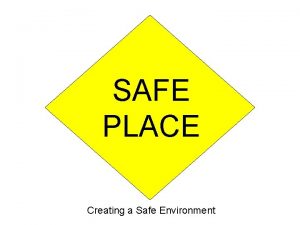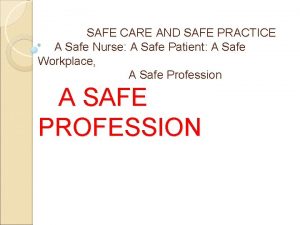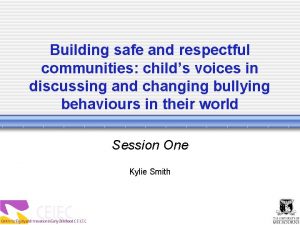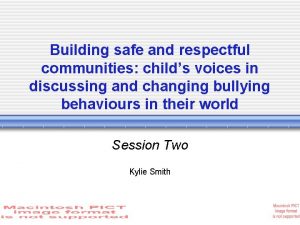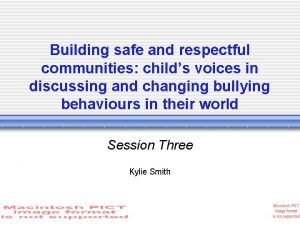Creating a Safe and Respectful Environment in Our


























- Slides: 26

Creating a Safe and Respectful Environment in Our Nation’s Classrooms Module 2: Creating a Supportive Classroom Climate

Introductions Name School(s) for which you work What subjects do you teach, and how long have you been teaching? When you close out your career as an educator, how would you like to be remembered by your students? 2

Workshop Objectives Participants in the workshop will: Consider what a supportive classroom climate looks like and how it can prevent bullying. Examine the role of teacher-to-student and student-tostudent relationships in building a supportive classroom climate. Explore strategies for preventing bullying in the classroom, including establishing a culture of respect for differences among students. Consider how a web of positive support among students and other adults across the school community can help prevent bullying. Identify and commit to use one new strategy for preventing bullying in their daily work with students. 3

Bullying Behaviors Defined Bullying is unwanted, aggressive behavior among school aged children that involves a real or perceived power imbalance. The behavior is repeated, or has the potential to be repeated, over time. Bullying includes actions such as making threats, spreading rumors, attacking someone physically or verbally, and excluding someone from a group on purpose. www. stopbullying. gov 4 Citation 13

Core Elements of Bullying Behaviors Bullying is a form of youth violence that includes: Unwanted, aggressive behavior A real or perceived imbalance of power between the student(s) doing the bullying and the student(s) being bullied Behavior that is repeated, or has the potential to be repeated, over time www. stopbullying. gov 5 Citation 13

A Supportive Classroom What would you see going on in a classroom in which there is a supportive climate for students? How would teachers be relating to their students and students with one another? What three words would you use to describe a supportive classroom climate? 6

Supportive Classroom Settings Engagement: includes relationships, respect for diversity, and school participation Safety: includes emotional and physical safety and reduction of substance use Environment: includes the physical, academic, and disciplinary environments and wellness 7 Citation 10

Effects of a Positive Classroom Climate In a positive school climate, students: Do better academically. Attend school more regularly. Feel better about themselves. Engage in fewer risky behaviors like drinking alcohol or using drugs. Engage less in bullying and other problem behaviors. 8 Citation 8

Willingness to Intervene When teachers and staff feel valued, they are more likely to become involved and intervene in a bullying situation. When teachers and paraeducators report high levels of connectedness, they report greater comfort levels intervening in a bullying situation. Feelings of comfort in being willing to intervene are correlated to: Knowing effective intervention strategies Knowing that others in the school also are likely to intervene 9 Citation 3

A Relational Problem Bullying is a relationship problem that requires a relationship solution. 10

Who Was There for You? Teacher Family Coach 11

The Little Things That Teachers Do Be available. Listen. Be positive. Have fun. Be real. 12 Citation 8

Student Intervention In the majority of bullying episodes in which students intervene, the bullying stops within: A. Two minutes B. Ninety seconds C. One minute D. Ten seconds 13 Citation 9

Inclusion Clear Classroom Norms Developed with student input Simple and understandable Posted in the classroom Fairly enforced with positive and negative consequences 14 Citation 8

Sample Anti-Bullying Rules 1. We will treat others with respect. 2. We will not use bullying behavior on others. 3. We will try to help students who are bullied. 4. We will try to include students who are excluded from groups. 5. If we know that somebody is being bullied, we will tell an adult at school and an adult at home. 15 Citations 8, 13

Respect is a learned behavior and attitude—we cannot make it happen, but we can teach and encourage it. Set a tone of respect in the classroom. Expose students to accurate information and positive representations of those who they may perceive as different from them. Talk about differences in a respectful way including examples of people with varied backgrounds and orientations. Provide time for learning and practicing positive, respectful behaviors. 16 Citations 1, 6, 8, 13

Communication can take many forms, including via: Posted norms Class lessons and meetings Individual conversations 17

Classroom Discussions Classroom discussions can: Raise awareness of ideas and strategies. Teach and practice the difference between respectful deliberationand intolerant dialogue around issues of difference. Provide opportunities for students to express their discomfort about witnessing bullying behaviors within the safety of a classroom discussion. Help students realize that they are not alone in their wish for bullying behaviors to stop. Provide an opportunity for students to brainstorm possible solutions to common situations involving bullying behaviors. 18 Citation 8

Intervention Skills Students can: Refuse to participate in the bullying behaviors. Tell the person to stop bullying. Tell a trusted adult what is happening. Be a supportive friend or ally to the student who is being bullied. 19 Citations 8, 13

Supportive Classroom Settings Engagement: includes relationships, respect for diversity, and school participation Environment: includes the physical, academic, and disciplinary environments and wellness Safety: includes emotional and physical safety and reduction of substance use 20 Citation 10

Engagement Be a role model by treating all students and colleagues respectfully. Teach the difference between respectful deliberation and name calling. Let students know you are available to talk. Use conversations with students to find out what is going on in their lives and actively listen. Encourage positive thinking and offer positive strategies for dealing with problems. Teach inclusively. Integrate examples of people from different backgrounds every day. Use inclusive language. Have fun! It will make personal connections and help students feel like they belong. 21 Citations 1, 6, 7, 8, 13

Environment Weave positive behaviors into daily interactions with students and colleagues. Set a positive tone in your classroom. Demonstrate appropriate boundaries and expectations for positive relationships. Examine your own beliefs, and examine your own assumptions, biases, or stereotypes. Work directly with both students who are being bullied and students who are bullying others. Establish a culture of respect for difference. Talk about differences in respectful and informative ways. Work with parents and youth to send a unified message against bullying. 22 Citations 1, 6, 7, 8, 13

Safety Step up during problematic situations, actively using your power to identify concerns and offer solutions. Make a safe culture the “norm. ” Encourage students to do what they love. Special activities can boost confidence, help students make friends, and protect them from bullying behavior. Make time for daily conversations with students about their lives and feelings. Ask a variety of questions when you talk with students. Talk about bullying behaviors. If concerns come up, be sure to respond. Read and learn about bullying. Create supportive ground rules for your classroom. Be positive—tell students what to do, not just what not to do. Teach positive relationship skills. 23 Citations 1, 6, 7, 8, 13

Building a Web of Support 24

Additional Support 25

A Legacy “Children are living messages we send to a time we will not see. ” John W. Whitehead The Stealing of America, 1983 Thank You for Participating! 26 Citation 14
 Ready respectful safe assembly
Ready respectful safe assembly Respectful learning environment
Respectful learning environment Awareness of ourselves and our environment is:
Awareness of ourselves and our environment is: Awareness of ourselves and our environment
Awareness of ourselves and our environment Our awareness of ourselves and our environment
Our awareness of ourselves and our environment Our awareness of ourselves and our environment
Our awareness of ourselves and our environment Having a courteous conscientious and respectful approach
Having a courteous conscientious and respectful approach Compassionate respectful and caring
Compassionate respectful and caring Creating an english environment
Creating an english environment Safe feed safe food
Safe feed safe food Safe people safe places
Safe people safe places Negative prefixes acceptable
Negative prefixes acceptable Fables about respect
Fables about respect Samoan greeting
Samoan greeting Respectful prefix
Respectful prefix Respectful
Respectful Step up model
Step up model Building respectful families
Building respectful families Vcaa respectful relationships
Vcaa respectful relationships Providing a safe and secure environment
Providing a safe and secure environment Financial environment of business
Financial environment of business How we can protect our environment
How we can protect our environment Chapter 1 section 1 understanding our environment answers
Chapter 1 section 1 understanding our environment answers Learning objectives of our environment
Learning objectives of our environment Our environment class 6
Our environment class 6 Section 1 understanding our environment answer key
Section 1 understanding our environment answer key Thinking language and intelligence
Thinking language and intelligence
